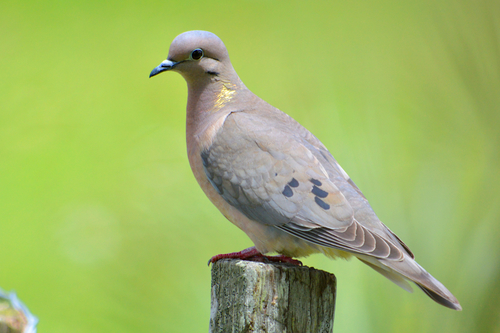
Eared Dove
The Eared Dove (*Zenaida auriculata*) is a widespread and adaptable bird species found throughout South America. It plays a significant role in seed dispersal and is a common sight in both rural and urban environments. Known for its distinctive dark marking near the ear region, this dove is a successful species, thriving in diverse habitats. While not globally threatened, it faces localized pressures from habitat loss and hunting in some areas. It is not particularly significant culturally, but it is appreciated for its gentle appearance and soft cooing vocalizations.
22-28 cm
Length
Approximately 45-50 cm
Wingspan
Least Concern
Conservation Status
Distribution
Found across South America, from Colombia and Venezuela in the north to Tierra del Fuego in the south. It is absent from the dense Amazon rainforest interior but present along its edges and in other habitats.
Lifespan
Typically 3-5 years in the wild, longer in captivity.
Eared Dove's Habitat
Habitat Types
Open woodlands, Savannas, Grasslands, Agricultural lands, Urban parks, Gardens
Climate Zones
Tropical, Subtropical, Temperate
Adaptations
Highly adaptable to various open and semi-open habitats; tolerates human-modified landscapes well.
Variations
There are 11 recognized subspecies, differing slightly in plumage and size across their range.
Appearance
Breeding Plumage
Generally similar year-round.
Seasonal Feather Changes
Minimal seasonal variation.
Sex Based Plumage Differences
Males and females have similar plumage.
Notable Features
Distinctive black streak behind the eye (the 'ear' marking), Iridescent blue-grey patches on the wings, Pinkish-brown overall coloration
Diet and Feeding
Primary Foods
Seeds, Grains, Small fruits, Occasionally insects
Foraging Behavior
Forages primarily on the ground, often in flocks. Picks up seeds and small food items.
Specializations
No specific morphological specializations, but its generalist diet allows it to thrive in diverse environments.
Seasonal Diet Variations
Diet may shift depending on seed availability; may consume more agricultural grains during harvest seasons.
Behavior
Social Structure
Often found in pairs or small flocks; can form large flocks outside of the breeding season.
Communication
Soft cooing vocalizations, Wing-whirring during flight displays
Migration
Generally non-migratory, but some populations may undertake local movements in response to food availability.
Territorial or Group Behaviors
Not strongly territorial; may defend a small area around the nest during breeding.
Conservation
Threats
Habitat loss due to agriculture, Hunting for food or sport in some regions, Pesticide exposure
Protection Programs
None specifically targeted at this species, but benefits from general habitat conservation efforts.
Local National Laws
Protected under general bird protection laws in many countries, but hunting may be permitted in some areas.
Population Trend
Stable
Population Estimates
Abundant and widespread; global population estimated in the millions.
Interesting Facts
Eared Doves are known for their rapid breeding cycle.
They can raise multiple broods in a single year, contributing to their population stability.
They are important seed dispersers.
By consuming seeds and moving across landscapes, they help plants colonize new areas.
The 'ear' marking is not related to hearing.
It is a visual feature, likely playing a role in species recognition.
They are often seen near human settlements.
They have adapted well to agricultural landscapes and urban environments.
Faqs about Eared Dove
What do Eared Doves eat?
They primarily eat seeds and grains, but also consume small fruits and occasionally insects.
Are Eared Doves migratory?
Most populations are non-migratory, but some may move locally in response to food availability.
How can I tell an Eared Dove from other doves?
Look for the distinctive black streak behind the eye, the 'ear' marking.
Is the Eared Dove endangered?
No. The Eared Dove is listed as 'Least Concern' by the IUCN, meaning it is not considered to be under threat of extinction.
Copyright @ Nature Style Limited. All Rights Reserved.
 English
English